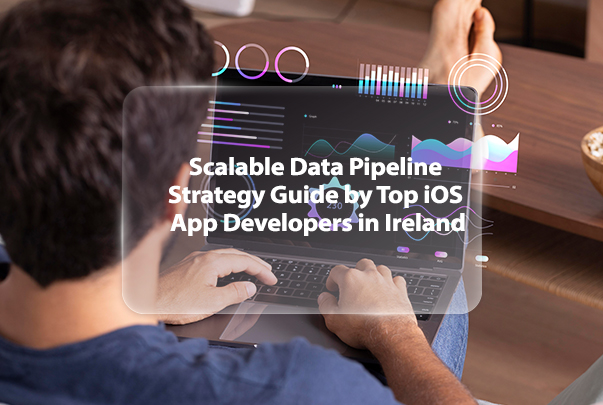For any business aiming to scale rapidly, the iOS app needs to be more than just a piece of software. It must be a reliable engine for handling customer data, as a messy data setup can act as a roadblock when the number of users starts to rise. It’s for this reason that leading iOS app development services in Ireland prioritize data resilience from day one.
This guide provides a focused, strategic look at how to build a Scalable iOS Data Pipeline to guarantee speed, stability, and integrity, turning your app into a reliable business asset.
The Business Cost of a Fragile Data Pipeline
Business leaders must understand how bad data management directly hurts the bottom line, turning technical issues into organizational weaknesses.
Data Mess and Slow Decisions
When customer information is spread across many different systems (the app, the servers, the analytics tools), we call these “data silos.” This fragmentation makes it impossible to get a clear, current picture of your customer.
- This lack of a unified view means marketing dollars are often wasted, and product teams can’t figure out which features to build next.
- Inaccurate data, including duplicates, makes executives doubt their reports, leading to stalled or wrong business decisions.
High Risk of Compliance Failures
For companies handling customer data, regulatory rules like GDPR are non-negotiable. The data flow is your main tool for managing these rules. If data is handled manually or without clear rules, basic requirements like tracking where data came from or guaranteeing the Right to be Forgotten becomes an auditing nightmare.
- A well-structured data setup builds security and privacy controls in advance, ensuring data is protected before it is even saved to the database.
- This “privacy by design” approach greatly reduces legal risk and makes compliance much simpler for everyone involved.
Two Core Data Architectural Strategies for Developers
Developers and technical architects need solutions that manage the reality of mobile networks (which are always unreliable) without crashing the app. This comes down to two simple strategies.
1. Strategy 1: Separate the App and the Server (Decoupling)
Decoupling means creating a clear separation between the app the user sees (the front of the app) and the powerful systems that store and process data (the back-end).
- Faster Releases: Development teams can work on the app and the server at the same time. If you update your analytics system on the server, you don’t have to force users to download a new version of the app, dramatically speeding up feature delivery.
- Isolated Resilience: If a server component fails, the app doesn’t crash. It continues to work smoothly using its own local data, preventing high-profile service outages that destroy user trust.
2. Strategy 2: Always Work Local, Sync Later (Local-First Sync)
Because cell service is always unstable (moving between Wi-Fi and 5G), the app must prioritize local storage first. It saves user changes instantly on the device and then syncs those changes to the server in the background when a stable connection is confirmed.
- Instant Feedback: Critical actions like saving a purchase or drafting a message happen instantly on the device, preventing slow, frozen, or annoying user interfaces.
- No Data Loss: This approach uses clear rules (like timestamps) to intelligently merge data when a local change conflicts with a remote update, guaranteeing that no user action is ever lost.
Developer and User Benefits With Scalable Data Pipelines
The best measure of a successful data strategy is a fast, seamless, and reliable user experience, which is the key to retention and positive reviews.
Always Working, Even Offline
By saving data locally first, the app remains fully functional even when the user is completely offline (e.g., on a subway or airplane).
- Effortless Sync: Once connectivity returns, the background sync manager automatically pushes all saved changes to the server. The user never has to worry about hitting a “sync” button.
- Better Battery Life: Efficient background syncing prevents the app from constantly draining the battery by hunting for network updates, reducing a major reason why users uninstall apps.
Clear Feedback and Fast Performance
Even when data is being processed in the background, the app must assure the user that their actions are safe and processing quickly.
- Visual Confidence: Instead of annoying loading spinners, modern apps use skeleton screens to show the content layout while data loads. Small, non-intrusive status indicators (like a checkmark) confirm that a local action has been safely uploaded to the server.
- Optimized App Store Scores: A clean data setup allows developers to consistently track and improve key metrics like API response times, ensuring the app always performs fast enough to earn high ratings.
Moving from Insight to Impact
We’ve seen that architecting a future-proof, scalable iOS data pipeline relies on two pillars: Decoupling and Local-First Sync. These strategies guarantee the stability, speed, and integrity your app needs to handle massive growth. The real value comes from flawless implementation.
If you’re ready to transition from strategy to execution and need specialized support to turn this robust architecture into reality, reach out to us. Innoenhance provides dedicated iOS app development services in Ireland focused on creating high-performance, scalable mobile solutions.
Ready to build a truly scalable iOS application?
Contact us today to transform your app’s stability and growth potential.



